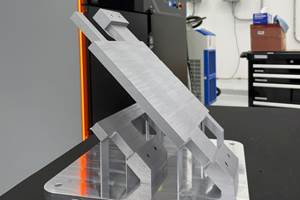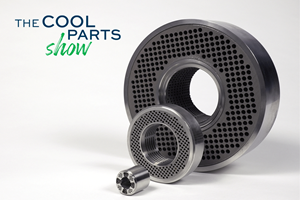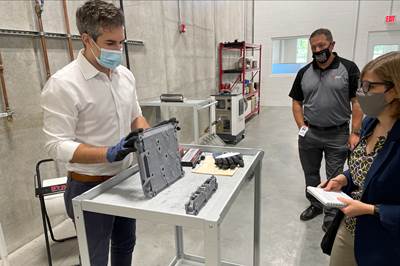3D Printed Brake Panel for the Rail Industry: The Cool Parts Show #52
In this episode of The Cool Parts Show, laser powder bed fusion simplifies the manufacturing of air brake panels for light rail systems made by Wabtec.
Share
Trains, subways and other forms of rail transportation rely on pneumatics for everything from door operation to braking systems. Brake control panels have been conventionally assembled from multiple machined metal parts, a manufacturing process that leads to extra weight and material, more potential fail points and connections, and difficulty in changing and customizing designs. At Wabtec’s Neighborhood 91 AM production facility, the company is solving these challenges with brake panels designed digitally and 3D printed through laser powder bed fusion. | This episode of The Cool Parts Show brought to you by Carpenter Additive
The Cool Parts Show is a video series from Additive Manufacturing Media that explores the what, how and why of unusual 3D printed parts. Watch more here.
Have a cool part to share? Email us.
Related Resources
- More on Wabtec’s 3D printing production
- What is Neighborhood 91? (coming soon)
- What is laser powder bed fusion?
Transcript
Stephanie Hendrixson
You've seen additive manufacturing make plane parts, you've seen it make car parts.
Pete Zelinski
Additive manufacturing for a train part on this episode of The Cool Parts Show.
Stephanie Hendrixson
This episode of The Cool Parts Show is brought to you by Carpenter Additive, the company's powder life solution is a combination of hardware and software technologies designed to help AM users manage their metal powders. Stay tuned after the episode for more on how the system works.
Pete Zelinski
I'm Pete.
Stephanie Hendrixson
I'm Stephanie.
Pete Zelinski
Welcome to another special on location episode of The Cool Parts Show.
Stephanie Hendrixson
That's right. We are here in Pittsburgh, Pennsylvania, at the Neighborhood 91 campus. Specifically, we are in the additive manufacturing production facility for Wabtec and we're here to learn all about this part.
Pete Zelinski
Wabtec, a well established manufacturer in the rail transport port industry, "W" "A" "B" tec, Westinghouse Air Brake, the original name of the company. Company name has changed, its scope of services has expanded, but it still serves that original special need, which is braking systems for rail transport systems for locomotives and other kind of vehicles that ride on rails.
The company sees significant promise in additive manufacturing to expand the engineering options that are available for locomotive braking systems and also streamline manufacturing and make it more cost effective.
Stephanie Hendrixson
And that's exactly what we're going to talk about today. Today's cool part is this 3D printed brake panel.
Pete Zelinski
Yeah. So what is this part? Let's learn more about that. Here is Brett Heher, who is additive design specialist with Wabtec.
Brett Heher
Most transit and train systems have a pneumatic controlled brake system, just like on large trucks. A brake panel is the mounting piece for all of the electronic controls for the braking system. Historically, brake panels have been milled out of plates, usually of aluminum that are about an inch to two inches thick. Then these milled plates are glued together or bonded together.
And the challenges there are you have multiple components that are sealed, and there's a potential for leaks, and the components are also quite heavy.
Pete Zelinski
Brake panel, basically a manifold that brings together all of these different pneumatic lines and pneumatic connections that are important for the operation and control of a braking system on a rail vehicle. This particular one is for a train car on a subway system, or maybe like a car you might find on a people mover at an airport, operates the brakes for a vehicle like that.
Stephanie Hendrixson
This particular brake panel, you would need two per car and these get customized based on the type of system that they're going into. So you might need the tubes in a different place. You might need to attach different types of modules. And the customization introduces some manufacturing challenges.
Brett Heher
So the reason that we want to be able to customize brake panels is because each transit system is inherently different around the world. They're made with different safety regulations, government regulations in place. They're controlled by different overarching software sets that have different requirements. And historically, transit systems are very old. So they have different station sizes and different station heights.
So there's just a lot that, over the life of transit systems, has driven a lot of customization to be needed for our different customers.
Stephanie Hendrixson
So moving this part to 3D printing allows for assembly consolidation, it allows for lightweighting. We're going to talk about all of that. But the primary reason to change to additive manufacturing here is that customization. If this part can live digitally and can be altered digitally, that dramatically simplifies that customization process. It becomes much faster to change the design and go right into manufacturing.
You're not changing out tooling. You're not dramatically altering your manufacturing process.
Pete Zelinski
So on The Cool Parts Show, we talk about mass customization a lot and Wabtec is doing the customization, but they're doing the mass, too. They are headed right toward mass production of products like this. So let's talk a little bit about what that production looks like.
Stephanie Hendrixson
Yeah. So let's talk about 3D printing. So we should say that this is not Wabtec's first rodeo with additive manufacturing. They have printing capacity at other facilities. They've been doing this for a while. But this specific facility here at Neighborhood 91 was established to be their additive manufacturing production space for aluminum parts. And so the equipment they have here kind of reflects the type of parts that they want to make.
The printer that we have behind us is the SLM 800. It's a large format laser powder bed fusion system from SLM Solutions. It has four lasers. It has a pretty large build box, and it's connected to the SLM Hub. So it's basically this self-contained system that does all of the powder handling, the de-powdering, kind of just keeps all of that powdered metal contained so that employees don't have to interact with it directly.
Pete Zelinski
This is a slender part, and I think that gives them some advantages when it comes to setting this up for 3D printing.
Stephanie Hendrixson
Yeah, that's right. So Brett told us they can print eight of these at a time, standing upright like this. The build takes about 100 hours because this is a pretty tall part and that might not sound super fast, but when you think about how these used to be made, this particular brake panel would have been six different parts that all had to be made separately and then joined together.
They can print it now as just one piece, so there's a pretty good time savings there just in not having to source all these different parts and bring them together. But that's not to say these are totally finished once they're done printing. Because these are pneumatic manifolds, it's really, really important to get all of that loose power out.
So that's done in a couple of different steps. They get de-powdered inside of the SLM hub. There's also an ultrasonic cleaning process that happens to really make sure that all those passageways are clean.
Pete Zelinski
And then comes machining. And machining is performed in this facility too, like basically in the same room. That small amount of machining capacity is all it takes to complete the production of parts that are made additively here.
Brett Heher
There is some machining that needs to be done on this brake panel. The first and most important is the mounting plane that all of the pneumatic components are mounted on. And we've designed the parts of that that machining can be done in one set up and one pass of machining. So it's really reducing the cost associated with machining there.
And then on the opposite side of the part, we have to machine the posts that are going to be used to connect to the transit side pneumatic system.
Pete Zelinski
So you have to compare that machining capacity to the amount of machining they had to do previously when this was an assembly of various different machine components. But I think we've learned more. We've learned something else about how assembly has been simplified in the design of this component.
Stephanie Hendrixson
That's right. So Wabtec has a simpler job in putting this brake panel together. It's also simpler for somebody to assemble into the final system. So that original machined version that we've been talking about weighed something like 14 kilograms. This one weighs 2.8 kilograms. So much easier for somebody to pick up, carry around, install into the system.
Pete Zelinski
Can we talk about tubes and connectors?
Stephanie Hendrixson
Let's talk about tubes and connectors.
Pete Zelinski
So this is what I want to talk about are these various teardrop shaped bosses, these elements that project from the form. These are elements of the design added to the additive manufactured version of this brake panel, and they save a considerable amount of cost and time and trouble in assembly.
Brett Heher
So one of the biggest changes between the conventional panel and the 3D printed panel is these 3D printed posts that we have included on the panel. Traditionally, you are connecting pipes for the pneumatic system on onto the brake panel. And then that connection is made using a typical NPT or G style thread, a tapered thread. That connection is not optimal or not optimized.
And so we've optimized it by printing a tube within the 3D printed panel. So now all that we have to do is couple the tube from the train side to the tube on the brake panel, and we don't have to thread any connectors.
Stephanie Hendrixson
So this one brake panel is bringing a lot of benefits on both sides. On Wabtec's side, from the perspective of the manufacturer, this is easier to make. It's fewer parts coming together. It's fewer steps in the process. But on the customer side, this is also a more reliable part. It's easier to install. It's easier to swap in and out in case something goes wrong.
But what we're talking about here is not just about this particular brake panel, this particular product, right? This is Wabtec working out how they can make brake panels like this of all shapes and sizes differently.
Pete Zelinski
So that's right. There's considerable lead time savings. We talked about that. But as a brake panel like this moves into full production, this is a very different way of doing manufacturing for Wabtec and a very different type of brake panel design for its customers. And as a part like this gets validated, goes into production, it clears the way and makes it easier for the next brake panel made this same way to follow that same path.
Brett Heher
So this brake panel is currently in the validation process. We go through a very extensive validation process for all of our braking systems and once that's complete, this will be the second brake panel that we put into service on a passenger rail vehicle. Being that it's modular, we can, like I said, customize what components are mounted to the brake panel.
And we can do that at a reduced time. So all we're doing is deleting a channel out of a 3D model. And then we have a partially validated part that we can print. In looking at traditional brake panels, that process would require having new drawings sets, tooling and CNC programs and everything like that, written and then procured in order to produce a new system.
So we're really cutting down on the lead time and engineering time.
Pete Zelinski
All right. Do you think we got this?
Stephanie Hendrixson
I think we've got this.
Pete Zelinski
All right, you start.
Stephanie Hendrixson
All right. This is a 3D printed brake panel for a light rail system, think subway, airport tram. It's basically a pneumatic manifold. So there's all these different tubes and things inside to move air through. This brake panel that we have here replaces a machined version that used to be six different parts that had to be assembled together. It used to weigh something like 14 kilograms.
It now weighs 2.6. So it's lighter. It's fewer components. It was 3D printed on the SLM 800 machine, which you see behind us, laser powder bed fusion machine. And it's made out of an aluminum alloy.
Pete Zelinski
It'll be manufactured here at Neighborhood 91 in Pittsburgh. New possibilities in design for brake panels for Wabtec. A new mode of manufacturing for this component. The manufacturing process, specifically a brake panel of about this size, eight of them at a time, can be fit on the build plate. They'll be produced eight at a time. Assembly consolidation success. Those six components are replaced by one. Assembly, further simplified by the replacement of connectors as separate components with these bosses, these connection features that are designed into the additive manufactured part.
Machining happens here at this facility as well. The parts are completed here entirely within this space.
Stephanie Hendrixson
And this will be Wabtec's second 3D printed part to be made here and validated and going on to rail systems soon.
Pete Zelinski
All right. That's it for this episode of The Cool Parts Show.
Stephanie Hendrixson
Thank you again to Wabtec for hosting us and for sharing their work on this brake panel. If you want to see more cool parts and more onsite episodes of the show, you can find all of those on our YouTube channel and at TheCoolPartsShow.com.
Pete Zelinski
If you want to learn more about Neighborhood 91, this special additive manufacturing campus that's coming together in Pittsburgh, Pennsylvania, we've written about it. We'll link to some articles in the show description.
Stephanie Hendrixson
And if you have a cool part you'd like to see featured, email us. CoolParts@AdditiveManufacturing.media.
Pete Zelinski
Thanks for watching.
Stephanie Hendrixson
Thanks again to our sponsor, Carpenter Additive. In addition to supplying metal powders, the company also offers services, software and hardware to help AM users manage their powder. One example is the PowderLife System, a combination of cloud based tracking software with hardware designed to make powder handling easier. Two key components are the PowderLife Hopper and the automated docking station.
Luke Boyer, manager of PowderLife Applications, and Andrew Holliday, Applications Engineer, explain how the system works.
Luke Boyer
So today, when a user of additive manufacturing is receiving powder, they oftentimes receive it in either five, ten, 15, maybe a 20 kilo bottle, but they're receiving pallets of them and you're receiving ten, 20, 50, hundreds of these bottles. The user has to look and segregate and store them appropriately, so the bottles don't get mixed up. And it requires a lot of lifting and moving and labor.
Andrew Holliday
The components of PowderLife are all based around making powder management systems on the additive manufacturing shop floor easier to use for the operator, cleaner, as well as more traceable. Three of those basic parts of PowderLife are our PowderLife Hoppers or our storage containers for powder. The second would be an automated docking systems that allows material to be pushed in and out of machines with no human contact.
The third would be our PowerLife Online software system that allows you to trace this powder as it goes through your shop floor.
Luke Boyer
The hardware and the software together just helps really streamline that and improve the final user's experience and let them concentrate on going from design to the part itself. It takes the headache of powder management out of the equation for them.
Related Content
What Does AM Want? Here Are 4 Aims (Maybe 5) That Additive Manufacturing Is Driving Toward
Certain freedoms and contributing factors allow additive manufacturing to realize its full promise for production.
Read MoreVariable Resistance Valve Trim Achieves Lead Time Reduction Through AM: The Cool Parts Show #69
Baker Hughes is realizing shorter lead times and simplified manufacturing through powder bed fusion to produce valve trims previously assembled from many machined metal parts.
Read MoreBike Manufacturer Uses Additive Manufacturing to Create Lighter, More Complex, Customized Parts
Titanium bike frame manufacturer Hanglun Technology mixes precision casting with 3D printing to create bikes that offer increased speed and reduced turbulence during long-distance rides, offering a smoother, faster and more efficient cycling experience.
Read More3D Printed "Evolved Structures" for NASA Exoplanet Balloon Mission: The Cool Parts Show #61
Generative design creates stiff, lightweight brackets for EXCITE mission monitoring planets orbiting other stars. The Cool Parts Show visits Goddard Space Flight Center.
Read MoreRead Next
Additive Manufacturing for Rail Industry Is Gaining Traction at Neighborhood 91
Locomotive manufacturer Wabtec is the first tenant of Pittsburgh’s N91 additive manufacturing ecosystem, where the company is ramping up production via laser powder bed fusion.
Read MorePostprocessing Steps and Costs for Metal 3D Printing
When your metal part is done 3D printing, you just pull it out of the machine and start using it, right? Not exactly.
Read More
.jpg;width=70;height=70;mode=crop)













